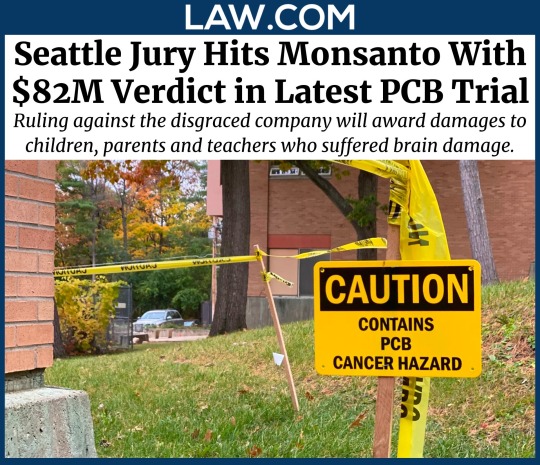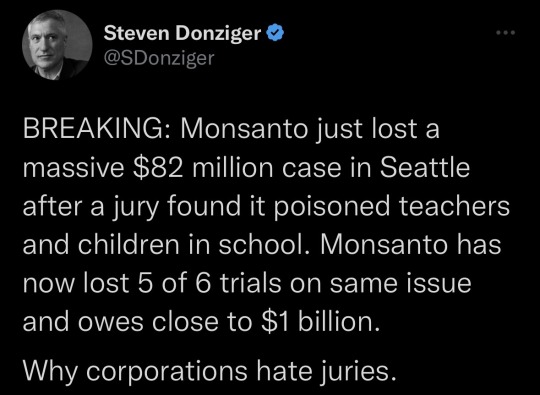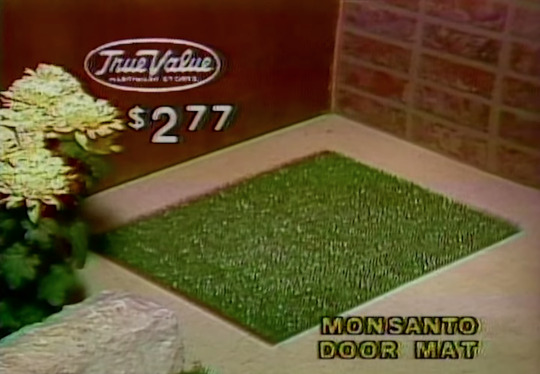#Monsanto
Text


Source
#Monsanto#capitalism#late stage capitalism#courts#corporatism#justice#Seattle#politics#us politics#government#the left#current events#news
3K notes
·
View notes
Text

Monsanto House of the Future at Disneyland, October 1958
#monsanto#house of the future#1958#1950s#vintage#disney#vintage disney#vintage disneyland#disneyland
508 notes
·
View notes
Text


April 1977. It's game-set-match! You have your winning tactic down pat. Warming up, playing rough or simply lounging. Fashion is where you make it happen.'
118 notes
·
View notes
Photo

Monsanto’s House of the Future at Disneyland, 1957
243 notes
·
View notes
Text

By iusedtobesometal
#monsanto#castelo branco#portugal#foggy#foggy aesthetic#green#cottagecore#photography#photographers on tumblr#gloomy#dark aesthetic
31 notes
·
View notes
Link
In 2015, a prestigious United Nations–affiliated health agency, the International Agency for Research on Cancer (IARC), designated glyphosate as “a probable carcinogen in humans,” and “found a particular association between glyphosate-based pesticides and non-Hodgkin’s lymphoma.” When the IARC issued its findings, the group’s credibility posed a significant public relations problem for Monsanto.
Monsanto’s denials that it knew about the potential dangers of glyphosate have been proven false by evidence that has come to light in recent years when public-interest litigators took the company to court and gained access to its internal communications.
Email communications from Monsanto staff revealed how the company launched a massive behind-the-scenes campaign to discredit the IARC and its allegations. Tipped off by the EPA before the IARC published its findings, Monsanto quickly began working on counter-messaging about the product’s classification as a likely carcinogen. The company’s chairman made public statements smearing the scientists as meddlesome activists peddling politically motivated “mischief” and “junk science.” The company planned to spend over $200,000 on a public relations campaign to discredit the IARC, working with agrochemical industry lobby groups to write letters to officials at the World Health Organization and regulatory agencies around the globe.
“Cozy” only begins to describe the relationship between Monsanto and the regulators. The company’s internal communications indicate that a telephone conversation took place between a Monsanto employee and an EPA scientist, Jess Rowland, during which Rowland told Monsanto that he would help to block a planned review of the evidence concerning glyphosate’s safety. Rowland was also asked by Monsanto if he would help the agency “correct the record” about the IARC study and was sent documents to guide the EPA’s responses to media inquiries.
Email communications also reveal how Monsanto’s chief of regulatory science, toxicologist William Heydens, explained to his colleagues how “ghost-writing” research articles for leading scientific journals works: they could pay nominally independent scientists to “have their names on the publication,” but Monsanto would actually be “doing the writing” and the authors “would just edit [and] sign their names, so to speak.” Heydens’ emails suggest that ghost-writing is not an atypical strategy for handling the company’s public relations concerns, and they go on to identify some prominent research papers that were written by Monsanto employees or affiliates. Notably, at least one ghost-written paper has been cited by the EPA as compelling evidence attesting to Roundup’s safety. This was but one of several ways the company corrupted science to defend its profits in disregard of public health.
103 notes
·
View notes
Link
“Most people have heard of open source software, maybe also of open source beer (Free beer for all!) or open source pharmaceutical research. The principle is the same: Someone developed the seeds — for cowpeas, corn, rye and more — and now offers the resource for everybody to share.
Just like software development has been co-opted by a few global companies like Microsoft and Apple, the international seed development and trade, too, is controlled by a few big giants like Bayer (Monsanto), Corteva (DuPont) and ChemChina (Syngenta). A 2012 Oxfam study found that four companies dominate more than 60 percent of the global trade with grains.
When we buy cereal or bread, few pay attention to the fact that most grains are protected or even patented. Most farmers don’t own the seeds they sow on their fields. “They are renting them,” Kloppenburg, professor emeritus at the University of Wisconsin-Madison and co-founder of OSSI says with disgust. The problem with that? “A few global companies have the monopolies on global seed trade, and they breed cash crops like corn and soy, purely for money. They don’t care about biodiversity, world hunger or about the small farmer.” What sounds like a business problem impacts everybody, Kloppenburg insists. “These few gene giants on top of the food chain decide what ends up on our plates.”
In 2012, Kloppenburg and half a dozen like-minded agriculture experts founded OSSI as an alternative to the monopolies. OSSI’s aim is the “free flow and exchange of genetic resources, of plant breeding and variety development,” Kloppenburg says. With global warming, disease and changing climatic patterns, “we need novel plant varieties that are capable of responding to the changes. Farm to table is popular, but we really need to talk about seed to table.”
The movement faces an uphill battle, particularly in the US where most farmers plant seeds that are patented by the big corporations. Still, about 50 seed breeders have already signed on with OSSI in the US to offer nearly 500 seed varieties. And other open source seed organizations are making their own way in Europe, Argentina, India and more...
Of course, salad is no software, and the work of plant breeders has to be protected. Otherwise they might fare like plant breeder Jim Baggett in Oregon, who in 1966 started breeding broccoli with an extra-long stem so it could be harvested more easily. He shared his novel broccoli with researchers and other breeders — until Monsanto-offspring Seminis patented a broccoli with exactly that trait in 2011. Baggett could trace more than a third of the plant material to his work...
Seed breeders who commit to the OSSI pledge allow buyers to use what they have developed however they like. The pledge reads: “In return, you pledge not to restrict others’ use of these seeds or their derivatives by patents or other means, and to include this Pledge with any transfer of these seeds or their derivatives.
Examples of OSSI varieties include dwarf tomatoes, bred for people with little space by small farmers in North Carolina and Australia who worked together and exchanged information across continents. A new rye, called Baldachin, has been developed with the help of crowdfunding in Germany specifically for the sandy soil in East Germany and is for the first time available in bakeries this fall. Also potatoes, corn, wheat and nearly everything else you need to cook dinner...
Just like software, “we want to go viral,” Kotschi says. In North America, he notes, cannabis breeders are interested in the OSSI strategy. “Cannabis is going to be a multibillion dollar market,” he says. “The small breeders fear for their seeds. They are interested in using the open source license to protect themselves while making the seeds available to others.”” -via Reasons to Be Cheerful, 10/14/22
#monsanto#genetics#patent#big ag#big agriculture#open source#plant breeding#farm to table#seeds#cannabis seeds#cannabis#ossi#good news#hope
109 notes
·
View notes
Text

Monsanto House of the Future, 1957
#monsanto#house of the future#1957#1950s#vintage#disney#vintage disney#vintage disneyland#disneyland
102 notes
·
View notes
Text

1943 Monsanto Advertising
#1943#monsanto#fruit#chemicals#strawberries#vintageadsmakemehappy#vintage magazine#vintage advertising#magazine#advertising#40s#1940s
15 notes
·
View notes
Text

By iusedtobesometal
#dark aesthetic#portugal#monsanto#castelo branco#green#foggy#cottagecore#cottagegore#gloomy#photography#photographers on tumblr#europe
8 notes
·
View notes
Text
Geoengineering like chemtrails, genetically modified organisms (gmo), weather control technology like HARRP, and mind control signals piggybacking on civilian wireless communications are apart of a planet terraforming plan by Reptilians working for the Archonian Empire that made a deal with the U.S. government after they started testing nuclear weapons. The radiation in the upper atmosphere from nuclear testing there was a form of energy seeding and cut off the Earth’s connection using its magnetic field with the rest of the galaxy.
9 notes
·
View notes




